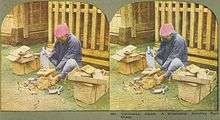William Habraken
William (Boy) Habraken is a shoe collector who resides in the Netherlands. His collection is housed in the SONS Museum in Kruishouten, Belgium. In 2006 the Guinness Book of World Records[1] recognized him as having the largest ethnographical shoe collection in the world.
Biography
William (Boy) Habraken was born at the end of World War II in Eindhoven, The Netherlands. At the age of twenty he separated from his father's shoe-business and started his own import/wholesale company in footwear. In 1970 he moved to Taiwan to become one of the first people to export shoes from there and China to Europe. He stood at the base of some of the largest footwear concerns in Europe. Extensive business travel brought him all over the world, visiting over 120 countries. On many of those trips and in his spare time he collected footwear which was part of traditional indigenous clothing. As important as the shoes themselves were to him, was the related information, such as; the materials used, the way of making, the use, the age and the name in the native language.[2]
Collection

Starting with his first pair in 1968, he acquired a unique collection of over 3000 pairs of shoes out of about 155 countries, states and territories. There are exceptional specimens of North-American Indians, Arctic Inuit, African tribes, Berber, Bedouin, Mongols, the Ottoman - and the pre-Inca empires. Extensive parts of the collection originate in Japan, India, Iran, Tibet and Pakistan. Europe is represented from Iceland to Russia and from Lapland to Spain. The collection has a broad range of footwear. Examples are Kadaichi shoes made of emu feathers and human hair (used by Australian native executioners). Beautiful bride-shoes from Afghanistan, India, Syria and Turkey. As a native of the Netherlands he of course also collected many wooden shoes.[3] [4]
Works
Tribal and Ethnic Footwear of the World
His ethnographical collection served as a basis for his influential book Tribal and Ethnic Footwear of The World, which tells stories of footwear around the world.[5]
Did the Gods Wear Shoes?
In his quest to unearth every possible detail of his collection and the history of each pair, he pondered the question of who wore the first pair of shoes. This question resulted in his second book with the title Did the Gods Wear Shoes.[6]
"The Golden Cow"
On December 12, 2013 the Schoenen en Lederwaren Sociëteit de Langstraat (SeLL) (Shoe and Leather Society Langstraat) announced that Mr. Habraken was the winner of The Golden Cow. Jury chairman Ellis French said "The jury admired the innovative and dynamic entrepreneurship of Mr. Habraken. As one of the first people he successfully pioneered shoes in the Far East. His vision has adapted to the ever-changing landscape of the industry. Along with that there is the passion with which he collects ethnic footwear from around the world, the associated stories recorded in books and the more than 2000 pairs he exhibits in a private museum, are all reasons why he deserves The Golden Cow! " [7]
References
- ↑ 2007 Guinness Book of World Records
- ↑ "Belangrijke mensen versieren hun voeten - Consument - RD.nl". Refdag.nl. 2013-09-10. Retrieved 2016-02-01.
- ↑ "SONS - Shoes Or No Shoes?". Shoesornoshoes.com. Retrieved 2016-02-01.
- ↑ "William Boy Habraken- Shoesornoshoes? SonS - Opening of the shoemuseum 2009". YouTube. 2010-12-04. Retrieved 2016-02-01.
- ↑ Kanamura, Yuniya (28 January 2016). Sneakers: Fashion, Gender, and Subculture. Bloomsbury Publishing. p. 22. ISBN 978-1-4742-6292-7.
- ↑ "Did the Gods wear shoes?". Archived from the original on 17 December 2014. Retrieved 21 February 2016.
- ↑ "Schoenenverzamelaar Habraken wint Gouden Koe 2013". Fashionunited.nl. 17 December 2013. Retrieved 2016-02-01.